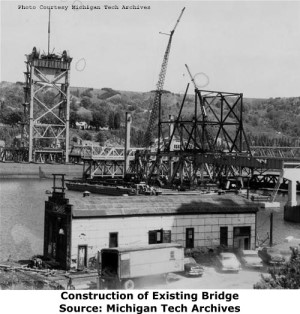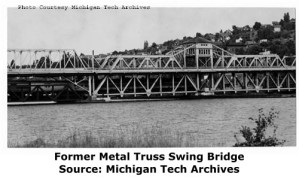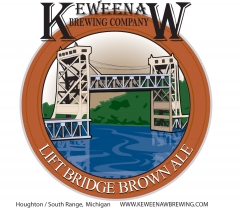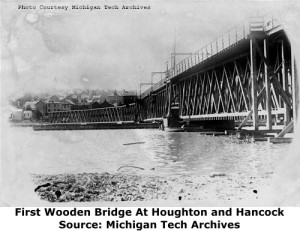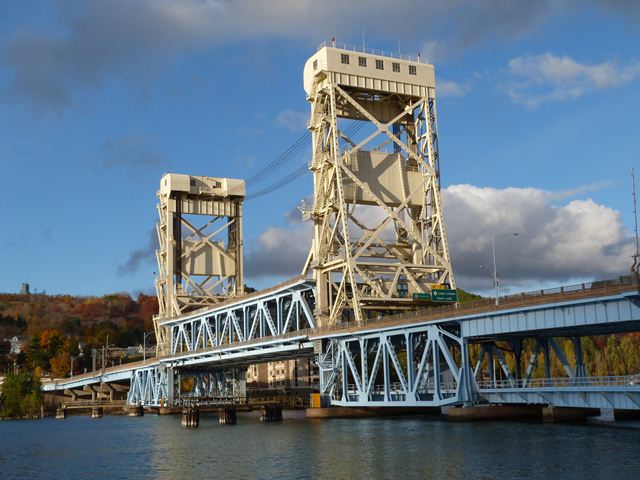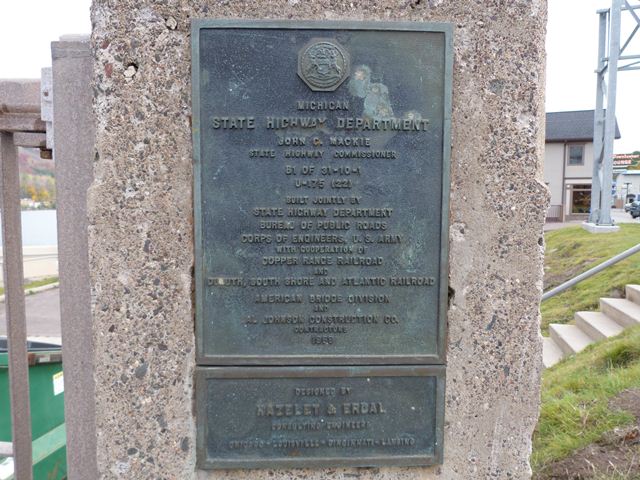We Recommend:
Bach Steel - Experts at historic truss bridge restoration.
BridgeHunter.com Phase 1 is released to the public! - Visit Now
Houghton Hancock Bridge
Portage Lake Lift Bridge
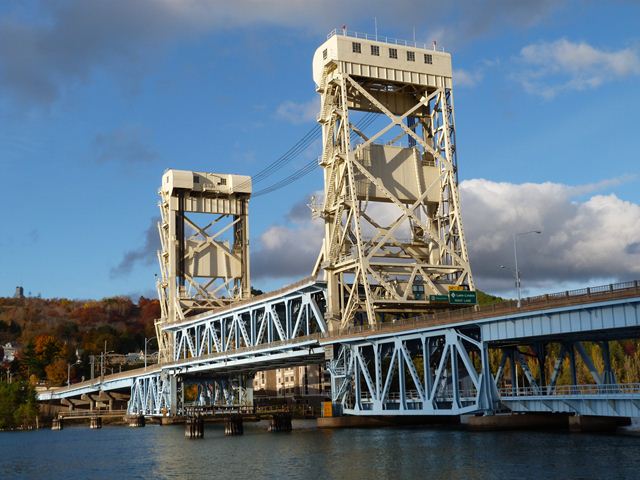
Primary Photographer(s): Nathan Holth
Bridge Documented: October 1, 2012
US-41 (M-26) and Rail-Trail Over Portage Lake (Keweenaw Waterway)
Houghton and Hancock: Houghton County, Michigan: United States
Metal 10 Panel Rivet-Connected Warren Through Truss, Movable: Vertical Lift (Tower Drive) and Approach Spans: Metal 6 Panel Rivet-Connected Warren Through Truss, Fixed
1959 By Builder/Contractor: American Bridge Company of New York, New York and Engineer/Design: Hazelet and Erdal of Chicago, Illinois
Not Available or Not Applicable
269.0 Feet (82 Meters)
1,310.0 Feet (399.3 Meters)
53.8 Feet (16.4 Meters)
1 Main Span(s) and 10 Approach Span(s)
3380

View Information About HSR Ratings
Bridge Documentation
Additional Information: As of 2022, this bridge is being listed as a National Historic Civil Engineering Landmark!
View Archived National Bridge Inventory Report - Has Additional Details and Evaluation
View Detailed ASCE National Historic Civil Engineering Landmark Nomination Authored By Emma Beachy and Michael Prast, Courtesy Professor Tess Ahlborn, Michigan Technological University
View Historical Article About This Bridge
About The Lift Bridge
The Houghton Hancock Bridge, officially known as the Portage Lake Lift Bridge, is the only bridge of its type in Michigan. When completed, it was the heaviest vertical lift span ever constructed. The unique bridge was designed as a double-deck bridge. The lower deck was designed for railroad traffic, and the upper deck was for highway traffic. However, to minimize the disruption of vehicular traffic on the bridge, the lower railroad deck of the lift span was designed to also accommodate vehicular traffic. This allowed the bridge to be raised slightly so that the railroad deck served the highway deck. While this would leave the railroad level of the bridge closed to trains, vehicular traffic could continue to cross the bridge, while allowing boats of intermediate size to pass under the bridge, where they would not have been able to do so if the left span was fully lowered. For large ships, the span could also be fully raised, which would completely stop traffic on the bridge. Today, trains no longer use the bridge, but the lower deck continues to serve as a crossing for snowmobiles in the winter. During the winter, the lift span is fully lowered, enabling snowmobiles to use the lower lift span deck level, while vehicular traffic uses the upper lift span deck level. At all other times of the year, the bridge is raised to the intermediate position, allowing vehicular traffic to use the lower lift span deck level, while closing off the unused lower snowmobile deck level. Today, the bridge does not appear to raise beyond the intermediate level frequently, since large ships do not use the waterway as often. However it does raise beyond the intermediate position occasionally for sail boats.
The bridge was designed be Hazelet and Erdal. This company was the successor to the noteworthy Scherzer Rolling Lift Bridge Company, which invented the Scherzer Rolling Lift type of bascule bridge. The Houghton Hancock Bridge showed that Hazelet and Erdal exceled at other movable bridge types as well. The Houghton Hancock Bridge, despite its noteworthy size and unusual double deck features, is an otherwise traditionally composed lift bridge for this period in history. Like most vertical lift bridges built in the 20th Century it utilizes some design techniques that were originally patented in 1893 by noted engineer J. A. L. Waddell, in particular the use of massive counter chains hanging from the counterweights, which maintain a consistent counterweight load as the span raises and lowers. The chains address the fact that as a lift span raises and lowers, the weight of the cables that hold the lift span shifts from over the lift span to over the counterweight and vice versa. However, typical of lift bridges from the middle of the 20th Century and later, the bridge also improves upon J. A. L. Waddell's original patented designs. Unlike most Waddell bridges, the Houghton Hancock Bridge does not place the electrical/mechanical equipment on the lift span, which requires a complex set of cables to connect to the towers and lift/lower the bridge. Instead, the equipment is housed in a fixed location within the towers.
As a bridge built for the Michigan State Highway Department (MSHD), the bridge also displays the appearance of a mid 20th Century State Trunk Line Bridge, in particular the use of MSHD's attractive type R4 railings on the sidewalk. These railings give the bridge a distinctive "Michigan" appearance. It should be noted that the R4 railings on this bridge are slightly different from the standard, with metal posts and the upper "hand-rail" portion of the railing being slightly different from the usual standard. Large bronze MSHD standard plaques are also mounted on the bridge.
The lower deck of this bridge has an unusual approach design at the southern end of the bridge. While still over the water, the railroad tracks split to the east and west, curving away from the centerline of the bridge on a series of deck plate girder spans. This split was not new to the lift bridge, since historical photos showed that the previous metal truss swing bridge also had this design.
Today, the Houghton Hancock Bridge is one of Michigan's most well-known historic bridges. The bridge is an icon for the Keweenaw Peninsula and the Houghton-Hancock area. The bridge is well-maintained by MDOT and it features an attractive two-color paint scheme with an off-white color for the towers and sky blue for the remainder of the bridge. Click on the image to the left to view the website for the Keweenaw Brewing Company which makes a beer called Lift Bridge Brown Ale and features an image the bridge on its bottles.
History of Previous Portage Lake Crossings
This crossing has a long history that is somewhat well documented, and reveals that this crossing's double-deck design extends back to previous bridges. The first documented crossing of the waterway was in the form of a wooden truss bridge, which was indeed a double-deck bridge with a railroad deck on the lower level and a highway deck on the upper level. At a later date, ca. 1891, when the War Department authorized the construction of a bridge over Portage Lake between Houghton and Hancock, a new bridge was built to replace the wooden bridge. This bridge was also a double deck bridge. It was a pin-connected metal through truss bridge with a through truss swing span as well.
The Annual Reports of the War Department for 1905 provided a description of an accident that destroyed the ca. 1891 metal truss swing bridge and resulted in the construction of a new metal truss swing bridge. It appears
that the unharmed approach spans were reused and not replaced at this time. The replacement swing span employed riveted connections, (as opposed to pin connections found on the older metal truss spans) which represented the evolution of
metal truss bridge design at that time. The text from the War Department is as follows:

The draw span of the Houghton-Hancock bridge was wrecked April 15, 1905, by the steamer Northern Wave, which struck the bridge while it was
being swung and threw the span over on its side, entirely blocking both channels. I visited the site at once and brought about an arrangement by which the two railroad companies, which operate the bridge, entered into contract, April 18,
with the Wisconsin Bridge and Iron Company to remove the wreck, and work began immediately. The south opening was cleared and open to navigation April 25. The remainder of the wrecked bridge was removed by May 25, and a locomotive tender
and flat car loaded with rails, which had fallen through a temporary pontoon bridge on April 17, were removed from the north channel by June 8.
A new draw span is to be built, of larger size than the old one, by the Copper Range and Mineral
Range railroad companies and Houghton County, in accordance with plans which were approved by the Secretary of War January 7, 1901, and a contract for its construction was awarded June 13, 1905, to the Wisconsin Bridge and Iron Company. The
plans provide for two draw- openings, the north one 108 feet and the south one 118 feet in clear width.
The bridge is expected to cost about $92,400, and the bridge company guarantees to have it in working order by March 1, 1906.
Information and Findings From Michigan Historic Bridge InventoryNarrative Description This monumental double-deck, vertical lift bridge is the only one of its type in Michigan. It replaced a 1905 steel swing bridge which had in turn replaced an earlier wooden swing bridge. The demands placed on
the design of this bridge were quite significant; not only was it necessary to accommodate automobile traffic, railroad and ship traffic also had to be considered. As a result, the vertical lift design was deemed most appropriate.
Suspended between two towers, the entire main span rises vertically between them. As long as the towers are built high enough, a vertical-lift bridge can accommodate just about any size ship that needs to pass beneath it. While every bridge has its problems, the unique design of the Houghton-Hancock Bridge allows for some strangely amusing ones. On June
24, 1960, the day before the official dedication, the steamer J.F. Schoellkopf almost collided with the crossing. Captain Albert Wilhelmy reported that he sounded the whistle signal for the bridge to open, but it never did. Reacting
quickly he ordered the engines reversed and dropped anchor. Unfortunately for the people of Hancock, the anchor became entangled in two of six Michigan Bell telephone cables that crossed the bottom of the channel. The steamer ran
aground in shallow water, and telephone service was cut off to 1,000 customers in and around Hancock. The bridge operator said he never heard the signal. The steamer was soon cut loose from the cables, towed back into the channel,
and continued her journey. |
This bridge is tagged with the following special condition(s): Double-Deck
![]()
Photo Galleries and Videos: Houghton Hancock Bridge
Structure Overview
Original / Full Size PhotosA collection of overview photos that show the bridge as a whole and general areas of the bridge. This gallery offers photos in the highest available resolution and file size in a touch-friendly popup viewer.
Alternatively, Browse Without Using Viewer
![]()
Structure Details
Original / Full Size PhotosA collection of detail photos that document the parts, construction, and condition of the bridge. This gallery offers photos in the highest available resolution and file size in a touch-friendly popup viewer.
Alternatively, Browse Without Using Viewer
![]()
Structure Overview
Mobile Optimized PhotosA collection of overview photos that show the bridge as a whole and general areas of the bridge. This gallery features data-friendly, fast-loading photos in a touch-friendly popup viewer.
Alternatively, Browse Without Using Viewer
![]()
Structure Details
Mobile Optimized PhotosA collection of detail photos that document the parts, construction, and condition of the bridge. This gallery features data-friendly, fast-loading photos in a touch-friendly popup viewer.
Alternatively, Browse Without Using Viewer
![]()
Maps and Links: Houghton Hancock Bridge
Coordinates (Latitude, Longitude):
Search For Additional Bridge Listings:
Bridgehunter.com: View listed bridges within 0.5 miles (0.8 kilometers) of this bridge.
Bridgehunter.com: View listed bridges within 10 miles (16 kilometers) of this bridge.
Additional Maps:
Google Streetview (If Available)
GeoHack (Additional Links and Coordinates)
Apple Maps (Via DuckDuckGo Search)
Apple Maps (Apple devices only)
Android: Open Location In Your Map or GPS App
Flickr Gallery (Find Nearby Photos)
Wikimedia Commons (Find Nearby Photos)
Directions Via Sygic For Android
Directions Via Sygic For iOS and Android Dolphin Browser
USGS National Map (United States Only)
Historical USGS Topo Maps (United States Only)
Historic Aerials (United States Only)
CalTopo Maps (United States Only)

